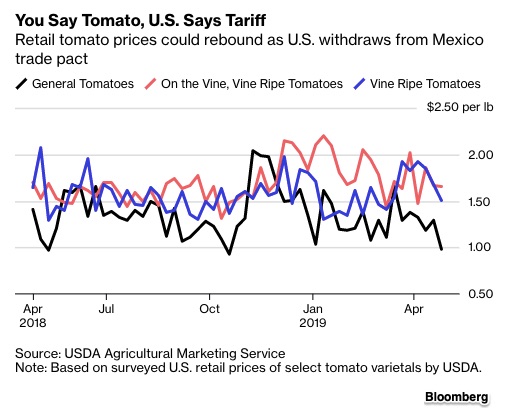We are eating a lot more tomatoes. One reason is the Mexican imports that pushed supply up and price down.
Yesterday, all of that was changed by a 17.5% tariff.
Tomato Tariffs
For years, U.S. tomato growers had tariff protection from import competition. Even after NAFTA’s free trade mandate, the U.S. perpetuated tomato protection with agreements that placed floors (minimum prices) on Mexican tomatoes. Still though the Florida Growers Exchange complained that Mexican tomatoes were too cheap.
You can see why the Florida growers have been unhappy. Mexican tomatoes now have a 54% market share:
Last February, the U.S. government responded. They gave Mexico 90-day notice that on May 7, yesterday, there would be a new tariff unless they had a revised tomato trade deal. They didn’t.
Our Bottom Line: The Tariff’s Impact
Just like washing machines, tomato tariffs will distort price and supply. This time, instead of appliances, our vine ripened, Roma, on-the-vine, and Field/Beefsteak tomatoes will cost more.
In an April report, researchers predicted that the consumer would be hit hard. At first fresh tomato prices could rise by 40% but then, next winter, it could be much worse. From the two dollar range, prices could jump 85% to more than four dollars a pound.
Until now, tomato prices have been relatively low:
Supply side reasons for the price hike take us to Mexico and the U.S. In Mexico, smaller farmers will probably produce less because of the added cost. Meanwhile, in the U.S., anything that decreases the crop like yellow leaf cur virus or a climate catastrophe will further cut supply.
Then, to all of this we can add more than 30,000 lost jobs in the U.S. After all, when those imported tomatoes enter the U.S., they have to be packed, distributed, sold, and perhaps processed. Also, some U.S. growers have partnership agreements with Mexican farmers that will be compromised.
But again, as with washing machines, the consumer is hit the hardest.
My sources and more: The Washington Post is a good starting point for more detail about tomato tariffs but I soon discovered that Western Farm Press was even better. Then, Bloomberg completed the picture.








